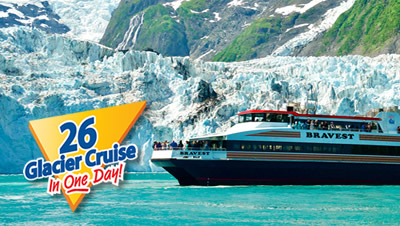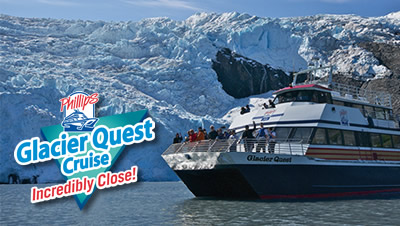Wildlife of Prince William Sound
While the glaciers are our focus, we encourage you to keep a keen eye out for the wildlife we see along the way. While at the glaciers, it is common to spot sea otters or seals hauled out onto the icebergs floating in front of the glaciers. It is possible to witness the migration patterns of whales, black bears, mountain goats, Steller sea lions, and Dall’s porpoise as you cruise the Sound during the season. The kittiwakes and bald eagles are always present in Prince William Sound. Our captains do their best to point them out to you, but we often rely on you, our guests as well to spot these critters as we travel. During the cruise, record the wildlife you see on our complimentary Captain’s Log.
Sea Otter

These playful little fissipeds (split-footed) mammals are familiar sights in the Sound. Long ago, glaciers left a shallow underwater area that is prime habitat for feeding. The otter, known for its rich pelt, has no blubber like other marine mammals to keep them warm and relies on a rich seafood diet, high metabolism, and constantly refreshing the air bubbles in its fur for warmth. Otters are known for being one of the only animals that use tools, such as rocks and to break open shells while feeding.
Harbor Seals
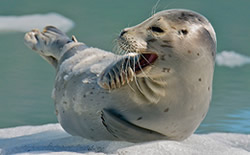
These sea creatures are regular sights on our cruises. They are graceful and efficient swimmers as they use their hind flippers for propulsion and fore flippers as rudders. You will encounter these beautiful animals resting on the ice at the face of the many tidewater glaciers visited on our cruises. Harbor seals are frequently relaxing on rocks, reefs, and beaches. They haul out to interact with other seals, give birth, raise their pups, and regulate their body temperature.
Kittiwakes / Birds

Annual migration patterns bring thousands of birds back to Alaska each summer to the Passage Canal rookery. To most of our guests, the Kittiwake looks like an ordinary seagull. However, when you observe them closely, you’ll discover they have black markings on their wingtips and black legs. As predators approach the rookery searching for eggs, the Kittiwakes will “peel off” the rock wall at once with their shrill warning sounds and create a barrier to protect their young.
Bald Eagle

The bald eagle is a sea or fish eagle and our national symbol. The Sound provides year-round and seasonal habitat for about 6,000 bald eagles. Scan the tops of the trees in Esther Passage or the dense spruce groves in the Chugach National Forest to see their bright white head scanning their surrounding for their next meal. If you are lucky, you may even see the bald eagle catch a fish!
Steller Sea Lion
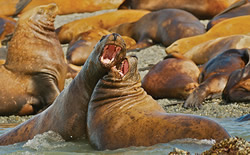
The Steller sea lion is the most prominent member of the eared seal family. Male sea lions weigh 2,000 pounds and are 10 feet in length. Mature males develop a heavy muscular neck with a mane of long coarse hair. Every summer, the Steller sea lions migrate to Prince William Sound and split their time between Perry Island and Egg Rocks’ rookeries.
Dall’s Porpoise
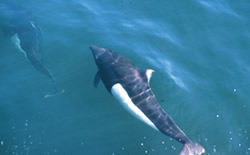
The Dall’s porpoise is found only in the North Pacific. Its thick body and small head make it easily distinguishable from other cetacean species. They are capable of swimming 30 knots and like to travel alongside our fast catamarans. As they zig and zag from one side of the boat to the other, guests try their luck at getting a photo of these fast-moving porpoises.
Mountain Goat
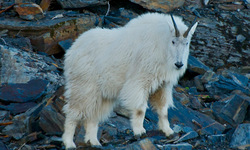
The mountain goat is the only North American envoy of a group of ungulates called the Ruplicaprinae, or rock goats. They are characterized by relatively short horns and live in rugged terrain. Adult males weigh about 260 pounds. Follow the jagged ridgelines from shore to the alpine zone and look for them traversing the craggy rocks. In the spring, we often see adult mountain goats with their “kids” learning how to navigate higher elevations as the snow melts. As the summer blossoms and the trees begin to grow new leaves, it can be a little harder to spot them.
Humpback Whales
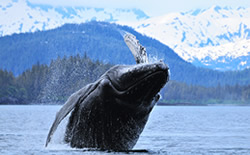
Keep an eye out for these gentle giants as we head towards the open waters of the Sound. You will recognize them by their giant spouts, easily seen from great distances. These whales are baleen whales that feed on some of the ocean’s smallest creatures and have giant flippers that can sometimes reach 30% of their entire length. These animals winter in Hawaii, giving birth to their young before returning to Alaska’s nutrient-rich waters.
Orca/Killer Whales

This member of the dolphin family travels throughout the Sound. The more docile orca whales are known as resident orcas and travel in large family groups or pods and feed on the salmon runs that make their way into Prince William Sound. They can be playful and are often very curious. The transient orca whales feed on marine mammals such as seals and sea lions and are not easily spotted, as they tend to be more stealthy. The resident pods can be spotted by the massive dorsal fins above the water as they travel, sometimes reaching up to six feet in height.
Minke Whale
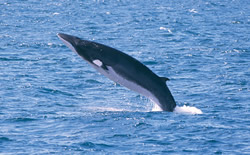
The minke whale is the smallest but most abundant of the baleen whales. Minkes have a characteristic white band on each flipper, contrasting with its very gray top color. Although not as commonly seen as the Orca or the humpback, we see them every season as they return to Prince William Sound’s rich waters.
Pigeon Guillemots

A member of the auk family, this seabird is found along the North Pacific coastal waters from California to Alaska and even Siberia. Often seen near bird rookeries during breeding times, they feed on small fish and marine invertebrates using their long black bill as their claws. Look closely, and you’ll see that the inside of their mouth and their legs are bright red.
Black Bears

Black bears are plentiful along the northern and western shorelines of Prince William Sound. Adult black bears stand about 29 inches at the shoulders and measure approximately 60 inches from nose to tail. Scan the shoreline and areas where the waterfalls and streams meet the saltwater. When the salmon return to the rivers, the bear activity increases.
Bears can harvest five species of wild Alaska salmon throughout the summer as they build up their body fat for winter hibernation. Can you name all five species of salmon?
Their black coats stand out against the spring snow and the fall colors, making them easier to see at those times of the season.
Phillips Cruises Wildlife
CAPTAIN’S LOGS:
Phillips Cruises and Tours provides narration in English on board during our cruises. We have also translated the information for our guests into the following languages: Chinese, Japanese, and Korean. Please see the links below to download a copy of our foreign language captain’s log for your reference. We recommend you download the file before arrival in Whittier as wifi is very limited and not provided by Phillips Cruises & Tours.
The content and images on the Website, Brochures, or Captain’s Log are not available for unauthorized use. To gain access to use our photos or content, please contact our sales and marketing department.


